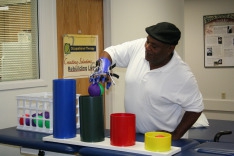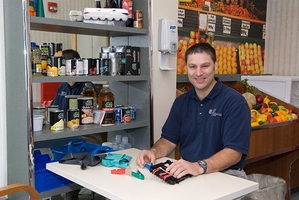Occupational Therapy
 The occupational therapy staff at OSF Rehabilitation is here for you when everyday life – from getting out of bed to getting dressed – becomes difficult. We see a wide range of ages and diagnoses.
The occupational therapy staff at OSF Rehabilitation is here for you when everyday life – from getting out of bed to getting dressed – becomes difficult. We see a wide range of ages and diagnoses.
Whether you’ve had an acute upper extremity sprain or something more serious, we are here to help you improve or restore your functional abilities so you can learn to live independently again.
Occupational tasks are all the activities that a person participates in on a given day. Examples include dressing, brushing teeth, eating, cleaning, money management, shopping, driving, parenting, and employment.
Who Is Occupational Therapy For?
Occupational therapy specializes in rehabilitation of the upper extremity and activities of daily living, whether it be from:
- Orthopedic surgery for shoulder, elbow, wrist, or hand
- TBI, Stroke, SCI, or head injury
- Carpal tunnel syndrome
- Hand and finger diagnoses
- Upper extremity weakness
- Fractures
- Pediatrics
- Hand therapy
How Does Occupational Therapy Work?
 Occupational therapists and occupational therapy assistants help people across the lifespan participate in the things they want and need to do through the therapeutic use of everyday activities (occupations).
Occupational therapists and occupational therapy assistants help people across the lifespan participate in the things they want and need to do through the therapeutic use of everyday activities (occupations).
Common occupational therapy interventions include helping children with disabilities to participate fully in school and social situations, helping people recovering from injury to regain skills, and providing supports for older adults experiencing physical and cognitive changes.
Occupational therapy services may include comprehensive evaluations of the client’s home and other environments (e.g., workplace, school), recommendations for adaptive equipment and training in its use, and guidance and education for family members and caregivers.
Occupational therapy practitioners have a holistic perspective, in which the focus is on adapting the environment to fit the person, and the person is an integral part of the therapy team.
Preparing for Occupational Therapy
You will need a physician’s referral to set up an initial evaluation appointment.
What to Bring
Please bring your insurance card and a photo ID. Please wear comfortable clothing and shoes.
When to Arrive
Arrive about 15 minutes prior to your scheduled visit to complete your registration process.
For children under the age of 18, a parent or guardian must be present for the initial appointment.
What to Expect
The first visit will take a little longer, approximately 45 minutes to an hour. This provides the therapist time to talk with you and gather information and measurements.
The therapist may give you a home exercise program to help get you started on your road to recovery.